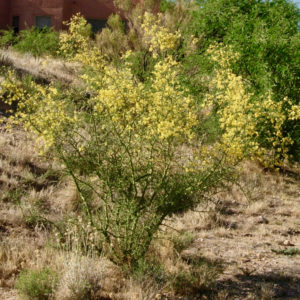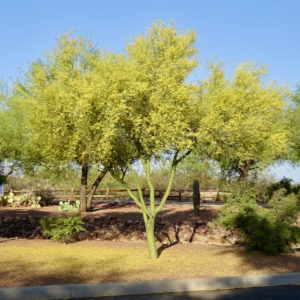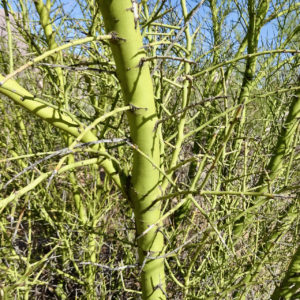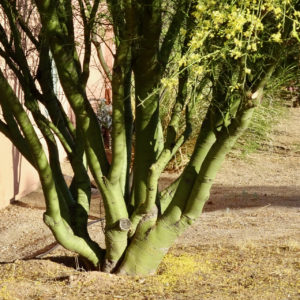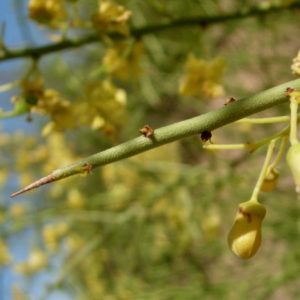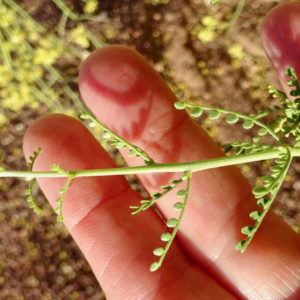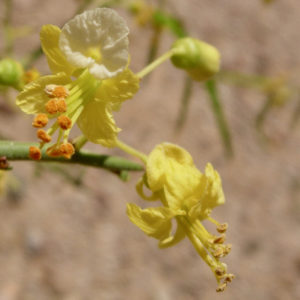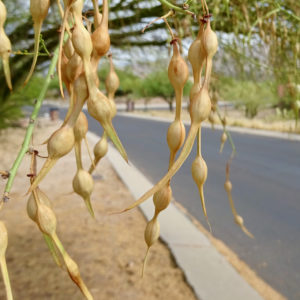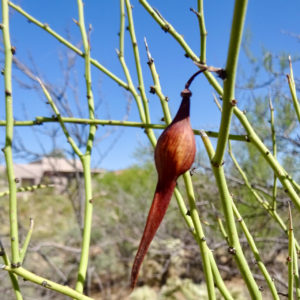Littleleaf Palo Verde
Parkinsonia microphylla
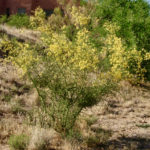
About the Plant
Littleleaf palo verde is a large shrub or small tree, often found on bajadas and lower mountain slopes in the Sonoran Desert. In years with ample rain it can paint the hills yellow in April and May, two to three weeks after the blue palo verde begin to bloom. Together with blue palo verde (Parkinsonia florida), littleleaf palo verde shares honors as the state tree of Arizona.
Littleleaf palo verde is a slow-growing but relatively long-lived tree - 100 years and possibly much more. Once established it can survive on natural rainfall, even on dry spots, but a few deep waterings in the hottest weather will help survival, encourage yearly flowering, and keep the plant from dropping branches. It will not tolerate waterlogged soils.
The little leaves of littleleaf palo verde are not a litter problem though the ground may become yellow with fallen flowers and the seed pods may look unattractive in a manicured landscape. This plant has a natural stiff, upright habit. It can be used in small spaces but keep away from walkways since the branches end in spines. Let littleleaf palo verde grow naturally or trim off the lower branches to facilitate movement under the tree. Make sure to prune only in warm weather as is does not recover well from pruning in cold weather.
Littleleaf, blue, and Mexican palo verde grow in the Tucson area. Hybrid palo verde ('Desert Museum' and 'Sonoran Emerald') are often planted. This guide will help you tell them apart.
Notes:
- Previous scientific name for this tree was Cercidium microphyllum and you may still see it listed under this name.
- Littleleaf palo verde is also known as foothills palo verde, reflecting its most common location, or yellow palo verde, indicating the color of the bark, which is a green with a more yellow tone than that seen in blue palo verde. Also, the flowers are a pale yellow.
- It is normal to see littleleaf palo verde leafless. New leaves may form two or more times a year, typically after summer and winter rains. As the soil dries, the leaves drop and the bark takes over photosynthesis, accounting for about 75% of the total photosynthesis of the plant.
- According to the Arizona-Sonoran Desert Museum, littleleaf palo verde is the primary nurse plant for saguaro cactus.
- Littleleaf palo verde was an important food resource for native peoples in Arizona. Flowers and young seeds are eaten raw and more mature fruit was cooked with meat or toasted and the seeds ground to flour. Seeds were also strung for necklaces.
Wildlife value:
- Insects as well as hummingbirds are attracted to the flowers. Small mammals feed on the fruit.
- Verdin and black-tailed gnatcatchers nest in littleleaf palo verde.
More Information
Horticultural information from ASU
Information from US Forest Service
Technical botanical description from SEINet
In books:
Native Plants for Southwestern Landscapes by Judy Mielke, page 107 (as Cercidium microphyllum)
Trees and Shrubs for the Southwest by Mary Irish, page 245
A Natural History of the Sonoran Desert, Arizona Sonoran Desert Museum, page 232 (as Cercidium microphyllum)
ID Characteristics
Littleleaf palo verde grows as a tall shrub but can also be trained as a small tree, usually with multiple stems. It typically grows to 15 feet x 15 feet and can reach to 25 feet in optimal situation. In landscape situations the lower branches are often removed to allow movement under the plant and to prune off the juvenile branches, low on the tree, that will never flower.
The bark is a yellowish green and performs most of the photosynthesis for the plant.
Even large trunks and branches retain the yellow-green color rather than turning darker with age.
There are no spines at the base of the leaves, but the tips of most small branches narrow to a sharp spine. Be aware of these spines when pruning or when choosing a location for the plant in your landscape.
The leaves are alternate and even bipinnate, 3/4 to 1 inch long. Each leaf has two, occasionally four, sections. Each section has 4-8 pairs of tiny leaflets that are only about 1/10 inch long.
The flowers of littleleaf palo verde are pale yellow and can be produced in abundance. The flowers have 5 sepals (bent backward in flower to the right in the photo) and 5 petals. One of the petals, called the banner, is white or a lighter yellow. The filaments holding the orangish anthers are of different lengths.
The fruit of littleleaf palo verde is elongated, always ending in a flattened, pointed "beak". Young fruit is green, then becomes tan and finally darkens to brown. The fruit contains 1-4 seeds and is constricted between each seed. One-seeded fruit are about 1.5 inches long. Fruit with more seeds can be to about 3 inches. A small hole in the pod indicates a larva of a bruchid beetle has made a snack of the seed.
